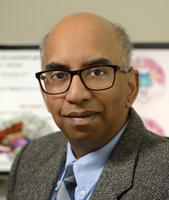Peter G. Daniels (30 September 1950 - 10 April 2012)
Peter Daniels - Mathematician who spent more than 30 years at City University studying fluid dynamics
From The Times (London, England) July 6, 2012
Peter Daniels, who was professor of applied mathematics at City University from 1985 to 2011, was a gifted mathematician who dedicated his life's work to the study of fluid dynamics.
He was born in 1950, the younger of the two sons of Frederick and Eileen Daniels, and grew up in northeast London. He went to Ilford County High School and was the first in his family to go to university, graduating with a first in mathematics from the University of Bristol in 1972. He gained a doctorate from University College London in 1974, working on the trailing edge of supersonic aerofoils under the supervision of Professor Susan Brown. His external examiner was Sir James Lighthill, a renowned applied mathematician and founder of the Institute of Mathematics and its Applications. Much later Professor David Crighton, then president of the Institute of Mathematics and its Applications, in his presidential address, cited Daniels' work as an example of how the method of matched asymptotic expansions coupled with computations enabled a sophisticated analysis of the 15 regions involved.
Daniels remained at UCL as a research associate, interacting with such significant figures in fluid dynamics as Keith Stewartson and Raymond Hide. But in 1977 he joined the mathematics department of City University, where he remained for the rest of his professional career - more than 30 years.Given the turbulence in British universities in the early 1980s, it says a lot that he rapidly progressed to a personal chair in 1985, and to head of department, succeeding Maurice Jaswon in 1987.
A surprising intrusion was provided over the period from 1988 to 1995 when Raoul Franklin, the vice-chancellor of City University, enlisted his help in solving the problem of the structure of electronegative plasmas, which were then coming into use in the manufacture of computer chips. Their work has proved definitive.
Daniels had a continuous stream of research students and research grants and maintained a steady output of research publications in fluid mechanics, particularly convection, amounting to more than 100 papers. He was much sought after to give seminars and to examine at undergraduate and postgraduate levels; he also refereed for numerous journals. He will be remembered as a conscientious, modest person, but one who gave a lot to those he interacted with on an intellectual level.
He is survived by his wife, Anne, and two children.
Peter Daniels, mathematician, was born on September 30, 1950. He died on April 10, 2012, aged 61
Over 100 papers on fluid mechanics by Daniels were published
